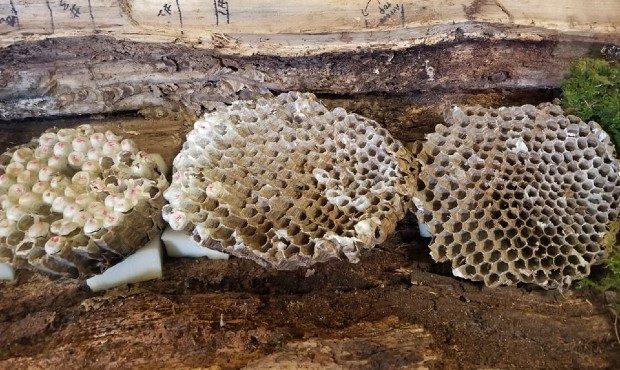State scientists hopeful eradicated hornet nest may be only one in area
Aug 27, 2021, 5:00 AM | Updated: 5:52 am

An Asian giant hornet nest on display at the Department of Agriculture's booth at the Northwest Washington Fair. (Photo courtesy of Christina Jennings)
(Photo courtesy of Christina Jennings)
Scientists with the Washington State Department of Agriculture are cautiously hopeful after eradicating the first Asian giant hornet nest of 2021 that it may also be the only one of 2021.
The nest, which was discovered in a decaying tree on private property east of Blaine — within a couple of miles of the spot where the department destroyed last October’s nest — was eradicated by Department of Agriculture entomologists early Wednesday morning.
State vacuums over 100 Asian giant hornets out of Whatcom County nest
Unlike last year, when scientists were fairly sure that there were other nests because of sightings throughout the northwestern part of Whatcom County — including in Blaine, Birch Bay, and Custer — only one hornet was spotted live by a resident this year. That photograph was taken by a homeowner two weeks ago, just a quarter-mile from where this nest was located. After that hornet was spotted, scientists were able to capture a hornet and track it to the nest with a GPS tag.
“Last year, I could tell you that we had probably three more nests because of our trap captures and our public reports,” said Sven Spichiger, managing entomologist for WSDA. “This year, we’ve had one positive public report and that’s all.”
Any nests from last year would have died out over the winter.
“Data right now from our trapping program and from the reports we have in do not suggest individual nests, but that’s why it’s so important for the public to keep submitting those reports,” Spichiger stressed.
WSDA will keep trapping throughout Whatcom County, and members of the public are encouraged to join in the effort with DIY traps. You can learn how to make your own with a juice bottle and some string .
Still, even if no more hornets are spotted this year, it will be too early for the scientists to declare victory. The department won’t officially consider the hornets eradicated in Washington until we have gone three years without a sighting.
“Within the next five years or so, we’re really trying to make sure we’re not having press conferences about this,” Spichiger said.
The nest that was just eradicated yielded around 1,500 hornets in different life stages — from eggs to adults — making it quite a bit bigger than last year’s nest. It was also found two months earlier, toward the beginning of Asian giant hornet season.
“To contrast that with the nest that we eradicated in October 2020, that one had approximately 500 life stages, so this one was almost three times the size and this early in the year,” Spichiger said.
He noted that these hornets were also stronger and more aggressive. The hypothesis is that the warm weather this spring and summer may have worked in their favor. Paul Van Westendorp, a provincial apiculturist with the British Columbia Ministry of Agriculture, Food, and Fisheries who is working on the hornet eradication effort in Canada, suggested that the hornets may be finding more food this year.
Most of the occupants of the hornet nest will be killed, but a few will be kept alive — in a tightly-controlled environment to prevent escape — for research purposes.
Luckily, even though these hornets were more aggressive, no entomologists from WSDA were stung during the eradication process.
WSDA has received two known reports of what it called “suspicious” stings from members of the public. Spichiger observed that photos of the stings showed that they “really had all the hallmarks of being Asian giant hornet” stings, but those who were injured were not able to submit a photo of whatever had stung them.
“Their physical reaction to them are consistent with what appears in the literature,” Spichiger said, noting that the injuries included severe pain and swelling.
However, he said, it could have also been native insects.
“There are other things that sting, and different people react to these other stinging insects in different ways,” Spichiger said.














